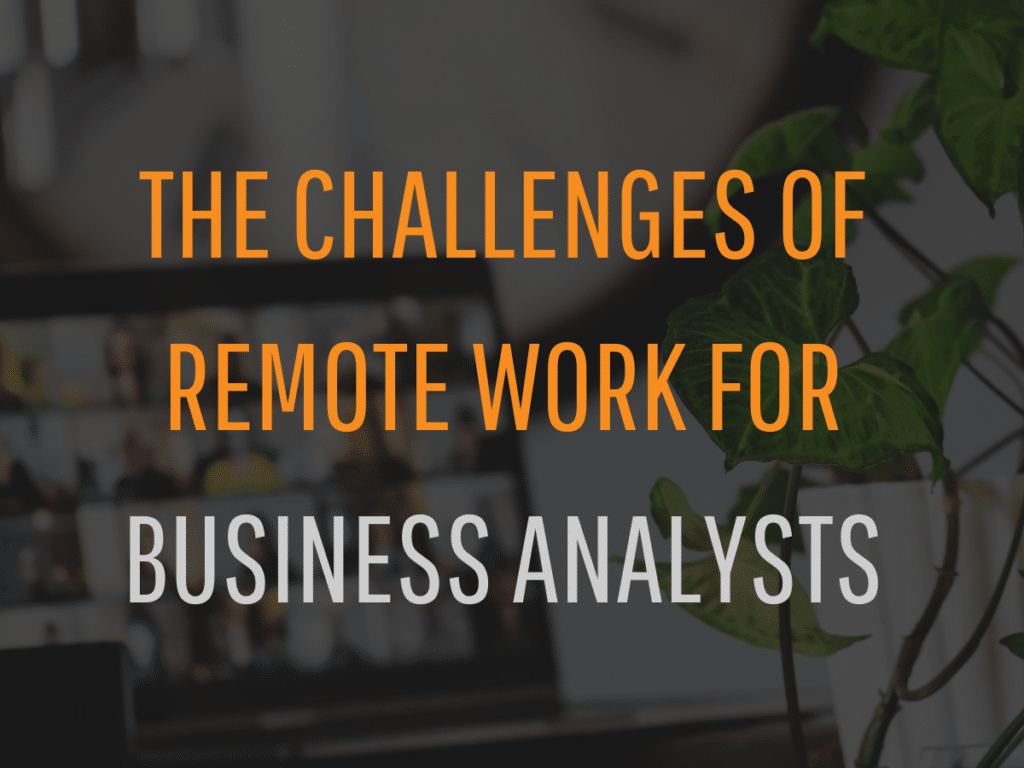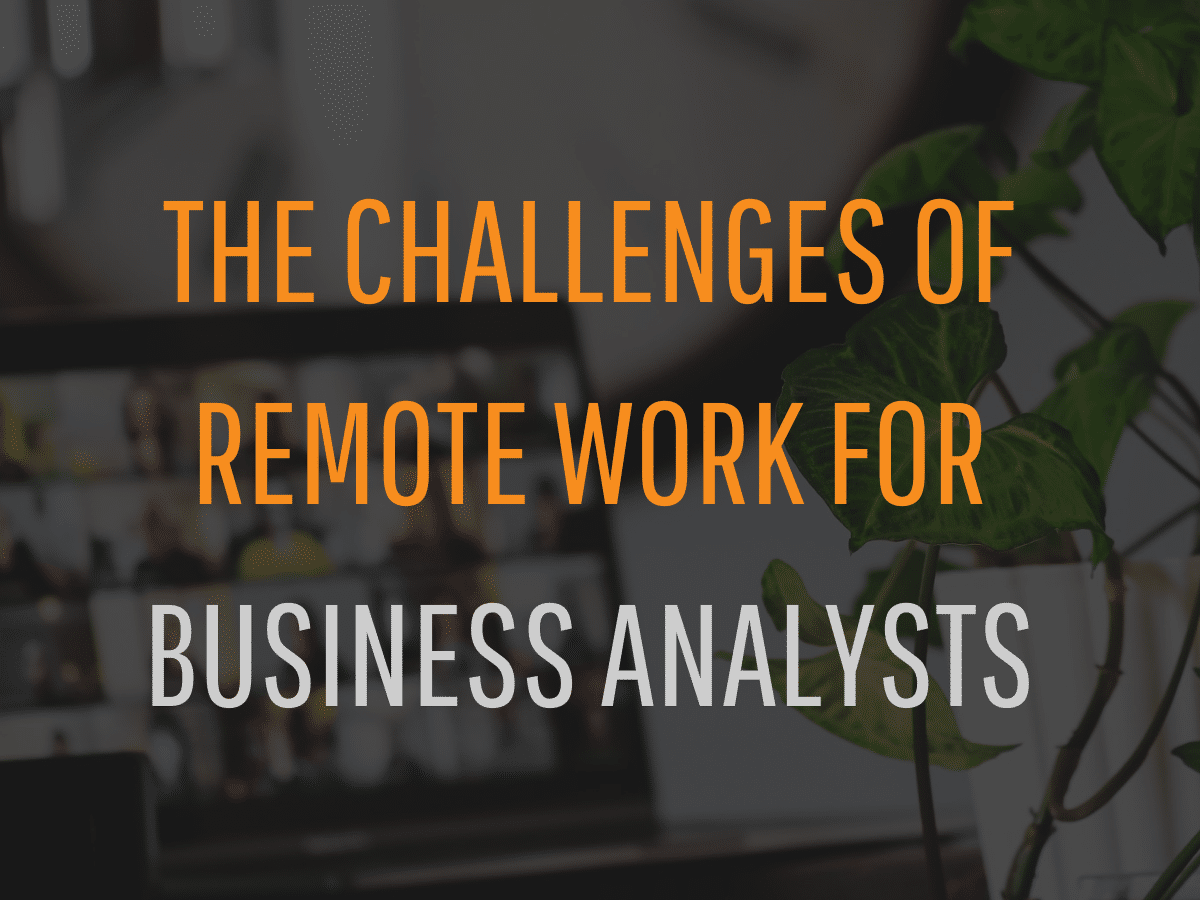Business analysts face unique challenges in a remote-only work environment.
Tech-enabled remote work has grown at an exponential rate over the last two decades. But, in many ways, the global COVID-19 pandemic was the final push that made it mainstream.
Many of us are reaping the benefits of reducing commutes and spending more time with family, providing a better life/work balance than before. For business analysts, however, there are some notable challenges to be overcome.
For business analysts, remote work can be both a blessing and a curse. Remote work has upended some of the most significant parts of the job and demanded analysts reassess the way they approach core elements of the job.
What Exactly Do Business Analysts Do?
Often, I meet people who assume business analysts spend all their time plugging away at spreadsheets inside windowless rooms, far away from human interaction. This makes the business analyst role sound like a tremendous remote position – but things aren’t so simple.
While I love cranking out process flows in a windowless room, that’s just part of a business analyst’s role. So much of what we do is sitting down with people at every level in the organization, learning the details of their role and identifying how they would improve specific problems we are working on, and finding out how they would like to improve things around them. This is where some of the most critical insights come from.
A business analyst’s job leverages each individual’s expertise – whether it comes from executive leadership or an entry-level worker – to define problems and make solution recommendations that detail a path to success. Then when we build a solution and then try and get everyone to adopt it, that’s where things get tricky.
Getting stakeholders to buy in isn’t easy. Every person needs to be supported differently. This might mean more training for some, more persuasion for others, or more governance overall. This is hard to do without being able to make genuine relationships with people.
Being a business analyst means identifying and understanding the obstacles that prevent people from doing their best work. Then, it means quantifying the impact of those obstacles and coming up with solutions.
Yes, much of the work of a business analyst is the actual analysis. However, the experience of sitting down with people and treating them as real people instead of data sources is game-changing for our results. But all of the above is informed by the experience of sitting down with people and asking them about the way they work.
How Remote Work Environments Impact the Business Analyst Workflow
Business analysts approach problems in a process-driven way. Flexibility is required, but the general problem-solving approach I use has four broad steps:
- Identifying and defining the problem
- Establishing an appropriate approach
- Gathering data and defining a solution
- Aligning stakeholders on the solution
All of this work relies on building trust and understanding differing perspectives. This is challenging enough in normal circumstances but becomes incredibly difficult when reduced to using video calls to conduct interviews, perform data gathering, run workshops, and, most importantly, build relationships.
Over the past year, I’ve faced challenges in each of these areas. I’d like to share some of the insights that this experience has given me.
Identifying and Defining the Problem
Finding the correct answer to the wrong problem is the surest way to fail a project. Collaboratively framing the problem is key to success, and to do it, you must be able to read body language. A little bit of hesitance or a subtle change in position can say a lot about how someone feels about their work. Importantly, these gestures often tell us things that people don’t want to say out loud.
This is where making time to build relationships plays an enormous role. A good business analyst uses time with stakeholders to learn about more than just what they do. We understand their goals and priorities, how they approach their day, and what they look forward to in and out of the office. We build relationships, and relationships build trust. When these interviews are remote, analysts may be tempted to skip this step and dive right in but will miss essential details in the process.
On a recent project working with team members across Europe, my team had to request multiple sessions with stakeholders in the busy season. Being able to talk about hobbies, share stories about kids, or commiserate on the impacts of COVID created a friendly relationship that changed us from “time-stealing consultants” to “the guy from Atlanta who thinks Thierry Henry is the best French footballer of all time.” This created an environment of openness and collaboration.
Pre-research takes on a much greater degree of importance now so that analysts and stakeholders can quickly get on the same page. In addition, collaboration tools can help make the process more interactive and, hopefully, draw people out of their shells enough for some personal insight to make its way into the conversation.
An output from a stakeholder who says, “This is how we do it,” is entirely different compared to a stakeholder who says, “This is how we do it because leadership says we have to.”
Establishing an Approach
Most problems have more than one solution. There is a near-infinite number of frameworks and models you can use to solve them. A core value of a good analyst is building alignment on the approach and bringing project champions along as we work the problem through to conclusion.
Finding data is a major challenge here. Getting access to good data can be burdensome for stakeholders, which is why analysts need to be diplomatic and persuasive when asking for it. In a face-to-face interview, it’s much easier to show stakeholders you have good intentions. Unfortunately, this isn’t easy to do over the phone. Reassuring stakeholders that you’re an outsider to office politics can be cumbersome when you are just another faceless voice they have to meet.
To address this, stakeholders need to be prepared and analysts must be proactive. Having an internal advocate that stakeholders respect and trust is a requirement. This person should ‘grease the wheels’ and add credibility to the business analyst. The champion should understand the approach and be able to minimize resistance before getting stakeholders involved. Also, talking to stakeholders early on helps them feel like part of the solution or even a semblance of ownership, making adoption later in the project much more manageable.
Defining a Solution
Once you understand the problem, have a reasonable hypothesis in place, and analysis underway, you can start building a formal solution. Workshops are one of my favorite methods for doing this. In the past, getting the right people in a room together focusing on a problem was a great way to build and align a solution.
Workshops were challenging even before the pandemic. Now, trying to keep a group of people focused while getting calls, responding to emails, and dealing with kids in the background is virtually impossible. Moreover, in a remote workshop, it is a struggle to make everyone feel like their voice matters and that they should contribute.
Without the ability to read body language cues from people, analysts need new ways to promote interaction. Collaborative tools and a little pre-work can make a significant difference, encouraging people to chime in with their ideas in a constructive way rather than interrupting someone else’s speech or waiting for the inevitable silence that always follows when a presenter asks, “Who has an idea for this particular problem?”
Tools like virtual whiteboards can help pull people’s thoughts out even if they don’t feel comfortable talking. Real-time wireframing, feature voting, prioritization, architecture diagrams, or even Gantt charts can be done with a myriad of tools. With a bit of creativity, business analysts can gamify these exercises, turning the virtual workshop into a welcome break from back-to-back phone calls. Being able to dry-run a particular activity is as important now as it always has been.
Aligning Stakeholders on the Solution
Change Management is often where recommendations fall apart. It’s essential to bring all stakeholders together throughout the project and align them before implementation. Having project champions along every step of the way has always been the best approach, but it can be harder to make their voices heard in a remote environment.
Today’s remote-enabled business analysts can address that challenge by asking project champions to bring completed fragments to presentations with their leaders prior to the end of the project. Having champions pre-sell ideas before presentations prevents meetings from going off the rails as leadership jumps from meeting to meeting and may not have time for context.
Good project and time management become crucial for planning pre-reads and setting expectations. However, this part of the project should not become a bottleneck.
Preparing for a Remote-Enabled Future
As the world recovers from the pandemic, many of us will be dusting off our suits and going back to the office. However, I suspect that many organizations will keep some form of work-from-home policies in place. Analysts may have to accommodate stakeholders being scattered even when we do travel to their offices.
Achieving better outcomes involves more than just doing what we’ve always done better. It also means adopting digital collaboration tools, being more proactive towards preparing stakeholders for change, and bringing creativity to how we engage with stakeholders. If we’re open to new methods for performing our jobs, remote work could be a huge opportunity to improve outputs and differentiate ourselves individually.





